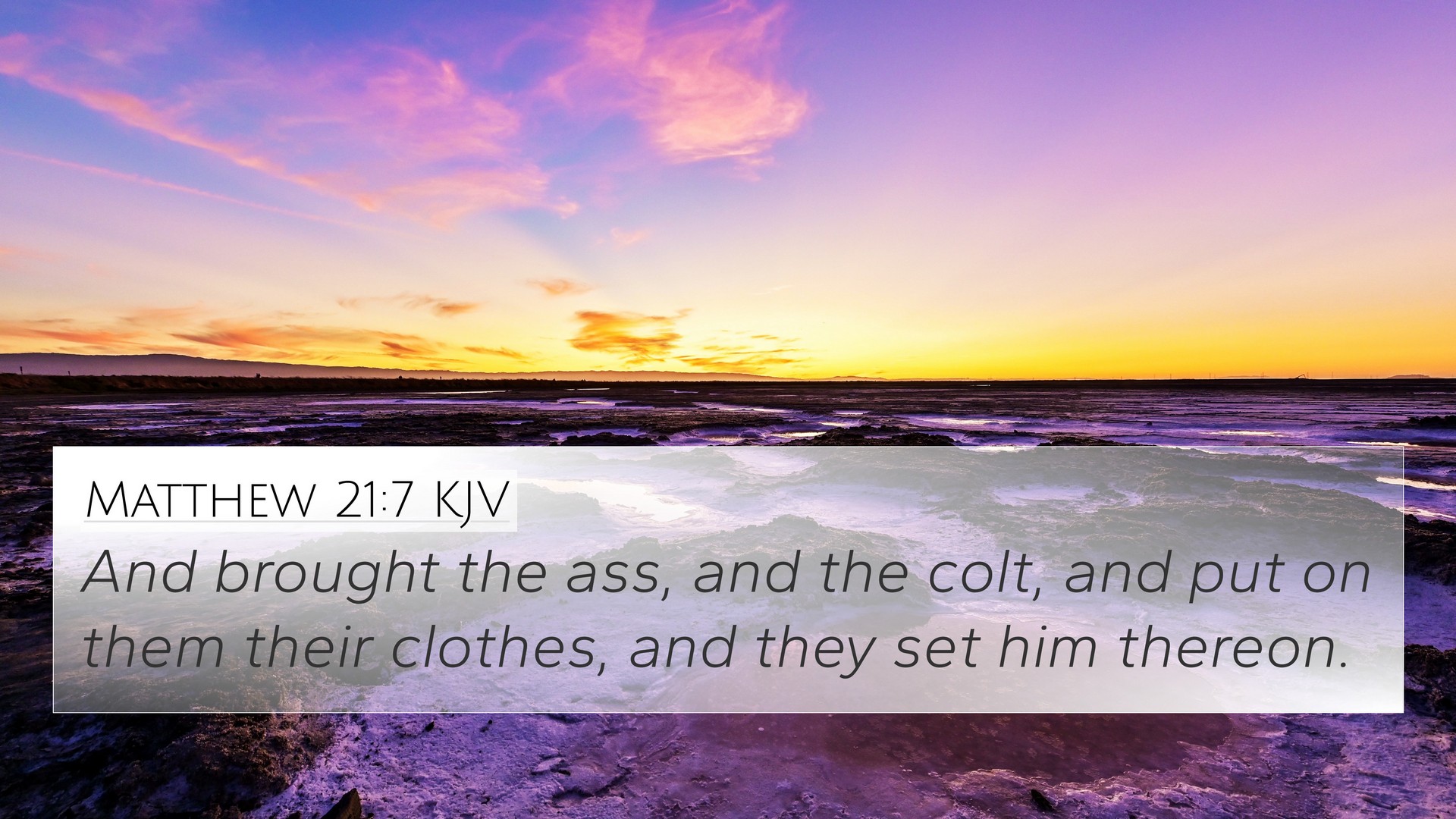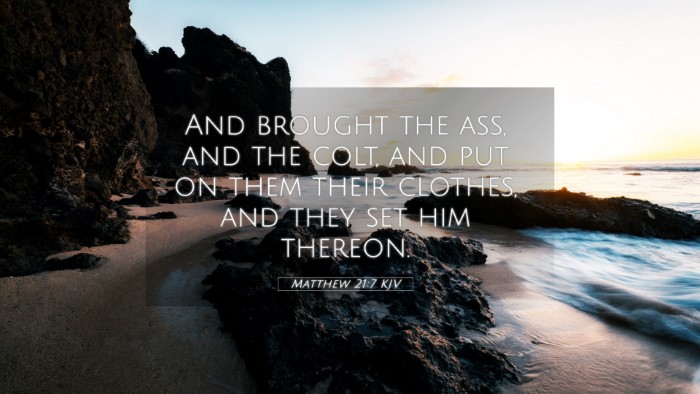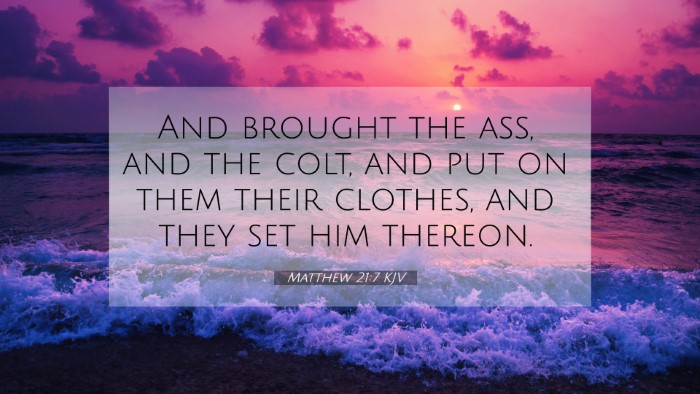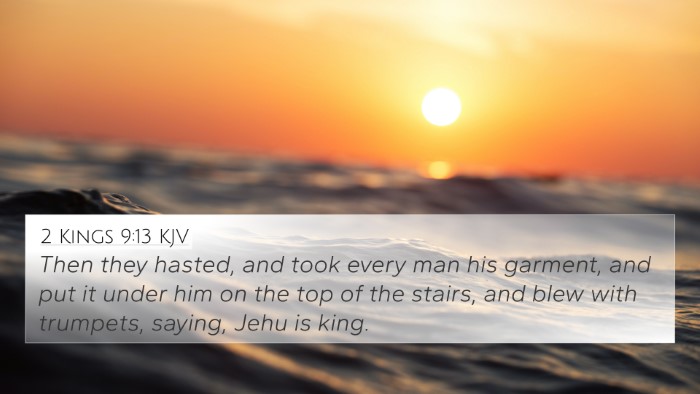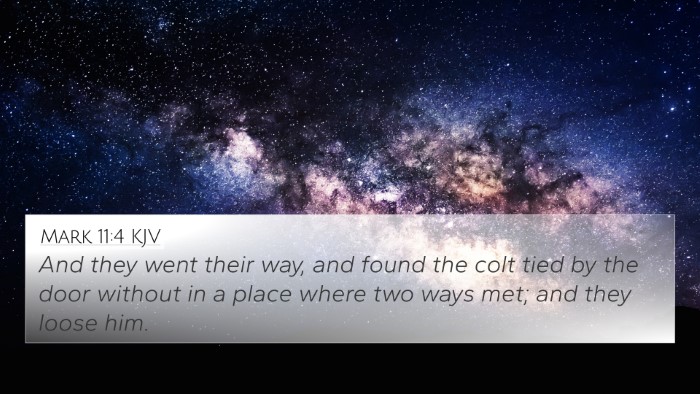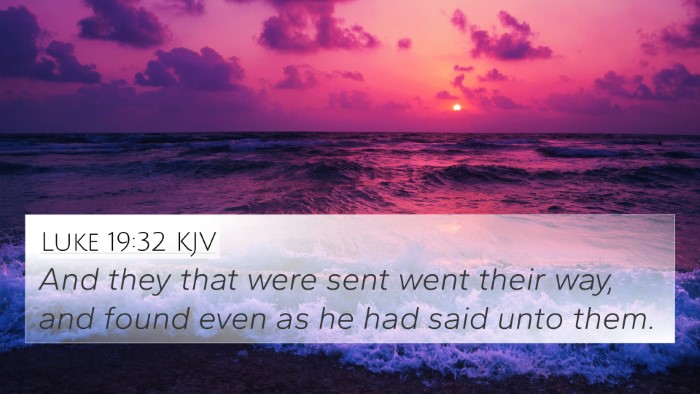Understanding Matthew 21:7
Verse: "They brought the donkey and the colt, laid their clothes on them, and set Him on them."
This verse portrays a pivotal moment in the New Testament when Jesus enters Jerusalem, fulfilling prophetic scripture and symbolizing His kingship. The actions of the disciples, fetching the donkey and colt, illustrate obedience and readiness in fulfilling God's plan.
Contextual Analysis
In this passage, Jesus rides on a donkey's colt, aligning with the prophetic declaration found in Zechariah 9:9. This demonstrates the fulfillment of Old Testament prophecies and establishes a direct link between the Hebrew Scriptures and the New Testament accounts.
Key Themes
- Fulfillment of Prophecy: The donkey and colt symbolize peace and humility, reflecting Jesus' approach to kingship as opposed to worldly power.
- Obedience to God's Will: The disciples follow Christ's instructions implicitly, showcasing their faith and commitment.
- Symbolism of the Donkey: In biblical times, kings riding donkeys represented humility, contrasting the expectations of a conquering hero.
- Public Declaration: The laying of clothes represents honor, indicating the crowd's acknowledgement of Jesus as the Messiah.
Connections to Other Scriptures
The significance of Matthew 21:7 can be further explored through a series of related Bible verses that illustrate the thematic connections across the scripture.
- Zechariah 9:9: "Rejoice greatly, O daughter of Zion! Shout, O daughter of Jerusalem! Behold, your king is coming to you; righteous and having salvation is He, humble and mounted on a donkey." This passage prophesies the very event Matthew describes.
- Isaiah 62:11: "Behold, the LORD has proclaimed to the end of the earth: Say to the daughter of Zion, 'Behold, your salvation comes; behold, His reward is with Him, and His recompense before Him.'" This emphasizes the arrival of God’s salvation through Jesus.
- Matthew 21:1-3: The immediate context where Jesus instructs the disciples to fetch the donkey and colt, indicating divine authority over all creation.
- John 12:14-15: John’s account of the triumphal entry adds depth, stating Jesus found a young donkey and sat on it, affirming the prophetic nature of His actions.
- Luke 19:35-38: Luke's perspective provides additional insights into the crowd's worship and celebration, showcasing the collective recognition of Jesus' lordship.
- Philippians 2:7-8: Reflects on Christ's humility, as He took the form of a servant and submitted Himself to death, presenting the broader context of His kingship through humility.
- Revelation 7:9: Portraying a diverse multitude, this further underscores the inclusive nature of Christ’s kingdom, as recognized during His entry into Jerusalem.
Comparative Insights from Public Domain Commentaries
Matthew Henry
Matthew Henry elaborates on the humility of Christ in this verse, emphasizing that His choice of a donkey reflects His character. This ride into Jerusalem is not only a fulfillment of prophecy but also a call to the people to embrace His peaceful reign, contrasting with the expectations of a political messiah.
Albert Barnes
Albert Barnes notes that the act of laying clothes on the animals signifies respect and honor. The transportation of Jesus illustrates how He fulfills the prophecies of the Old Testament while presenting a paradigm shift in Jewish expectations of the Messiah.
Adam Clarke
Adam Clarke provides insights into the cultural implications of this event. The donkey symbolizes peace, and its use contrasts with kings who would typically ride horses into battle. This reflects on Jesus' mission, which was to bring peace and reconciliation rather than political upheaval.
Thematic Bible Verse Connections
When studying Matthew 21:7, it's crucial to consider its connections with other scripture, providing a robust framework for understanding its implications in Christian theology:
- Humility in Leadership: Reflect on Micah 6:8 which calls for justice, mercy, and walking humbly with God, aligning with the character of Christ as showcased in Matthew 21:7.
- Messianic Prophecies: Analyze connections with Psalm 118:26, which prophesies the coming of the king blessed by the people, enhancing the understanding of Jesus' role as the messianic figure recognized by the crowd.
- Joy and Celebration: Connecting to Luke 2:10-11, where the good news of great joy is proclaimed, the crowd's expectation mirrors the joy of Christ's entry into Jerusalem.
Applying Cross-Referencing Methods
To delve deeper into the scriptures and their interconnected narratives, employing tools for Bible cross-referencing is essential. Here are some methods and resources:
- Using a Bible Concordance: This can help identify keywords and corresponding verses that share similar themes or messages.
- Bible Cross-Reference Guide: Guides such as these can provide a curated list of verses that relate directly to Matthew 21:7 and its themes.
- Cross-Reference Bible Study Tools: Utilizing resources that enable thematic studies can enrich understanding of Jesus’ entry and its implications.
Conclusion
Matthew 21:7 encapsulates a moment of divine fulfillment and intentional humility. Through cross-referencing biblical texts, one can unveil deeper meanings and connections between the Old and New Testaments, enriching one's understanding and faith.
Further Study
For those engaging in deeper biblical study, consider exploring:
- How to find cross-references in the Bible, focusing on search methods for thematic analysis.
- Identifying connections between the Old and New Testament to see how narratives converge and diverge.
- Comparative studies between the Gospels to understand each writer's perspective and thematic emphasis.
Through diligent cross-referencing and study, believers can appreciate the complexity and richness of Scripture.
